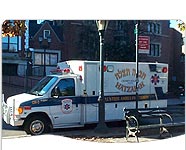 |
 
Heat Stroke
Heat stroke
occurs when the body is unable to regulate its temperature.
The body's temperature rises rapidly, the sweating mechanism
fails, and the body is unable to cool down. Body temperature
may rise to 106°F or higher within 10 to 15 minutes. Heat stroke
can cause death or permanent disability if emergency treatment
is not provided.
Recognizing
Heat Stroke
Warning
signs of heat stroke vary but may include the following:
- An extremely high body temperature (above 103°F, orally)
- Red, hot, and dry skin (no sweating)
- Rapid, strong pulse
- Throbbing headache
- Dizziness
- Nausea
- Confusion
- Unconsciousness
What
to Do
If you see
any of these signs, you may be dealing with a life-threatening
emergency. Have someone call for immediate medical assistance
while you begin cooling the victim. Do the following:
- Get the victim to a shady area.
- Cool the victim rapidly using whatever methods
you can.
For example, immerse the victim in a tub of cool water; place
the person in a cool shower; spray the victim with cool water
from a garden hose; sponge the person
with cool water; or if the humidity is low, wrap the victim
in a cool, wet sheet and fan him or her vigorously.
- Monitor body temperature, and continue cooling efforts
until the body temperature drops to 101-102°F.
- If emergency medical personnel are delayed, call the
hospital emergency room for further instructions.
- Do not give the victim alcohol to drink.
- Get medical assistance as soon as possible.
Sometimes
a victim's muscles will begin to twitch uncontrollably as a
result of heat stroke. If this happens, keep the victim from
injuring himself, but do not place any object in the mouth and
do not give fluids. If there is vomiting, make sure the airway
remains open by turning the victim on his or her side.
Disclaimer:
These
self-help measures are not a substitute for medical care but
may help you recognize and respond promptly to warning signs
of trouble. Your best defense against heat-related illness is
prevention. Staying cool and making simple changes in your fluid
intake, activities, and clothing during hot weather can help
you remain safe and healthy.
Back to Safety Tips Index
|









